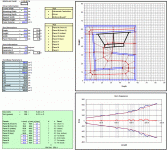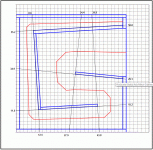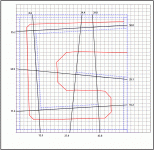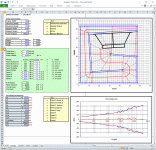Nice Brian!
The main difference as I see it is the slightly angled end piece in the aperture making up the expansion between S3-S4 (or S4-S5 depending on sim resolution), I looked at this specifically during the THAM15 development but decided to leave it out since I was set on making the design as simple to build as possible (having only one 3deg. angled cut).
I do not know if it has any greater bearing on the external volume, but the THAM15 was designed using 18mm baltic ply, not 17mm as above, is 17mm an approximation inches to mm. ?
The main difference as I see it is the slightly angled end piece in the aperture making up the expansion between S3-S4 (or S4-S5 depending on sim resolution), I looked at this specifically during the THAM15 development but decided to leave it out since I was set on making the design as simple to build as possible (having only one 3deg. angled cut).
I do not know if it has any greater bearing on the external volume, but the THAM15 was designed using 18mm baltic ply, not 17mm as above, is 17mm an approximation inches to mm. ?
On a side note I can't help but to feel a little bit proud that this designs still attracts attention some 6 years after it was published (Tuesday, July 21, 2009, 11:04) as the first of the now four strong lineup of THAM models, all following the same baseline balancing, 40-50hz and up as compact and simple to build as I was able to make them.
Today the DIY field looks quite a bit different, we have all learned a lot in 6 years and our main simulation software, Hornresp, with out which I'm sure things would have been very different, has been developed as well, as have the drivers now available, so perhaps it's about time we revisited the whole THAM baseline setup, applying the current knowledge and understanding while trying to remain true the original design goals ?
In short, do you fell is it time to revisit the THAM design(s) once again? and see how much smaller, lighter and more capable can we get given the 40Hz to 50Hz & up constraint this time around ?
The latest effort on my part to develop the folding was the THAM18 which I still believe to be the most efficient THAM design to date with regards to size.
sorry for the OT, just thought I'd take the chance to see if there would be an interest in such a thing, that's all.
Now - back on topic 🙂
Today the DIY field looks quite a bit different, we have all learned a lot in 6 years and our main simulation software, Hornresp, with out which I'm sure things would have been very different, has been developed as well, as have the drivers now available, so perhaps it's about time we revisited the whole THAM baseline setup, applying the current knowledge and understanding while trying to remain true the original design goals ?
In short, do you fell is it time to revisit the THAM design(s) once again? and see how much smaller, lighter and more capable can we get given the 40Hz to 50Hz & up constraint this time around ?
The latest effort on my part to develop the folding was the THAM18 which I still believe to be the most efficient THAM design to date with regards to size.
sorry for the OT, just thought I'd take the chance to see if there would be an interest in such a thing, that's all.
Now - back on topic 🙂
... and here we go - 190L in total.
Wow! That's one cool little noise maker!
Last edited:
I do not know if it has any greater bearing on the external volume, but the THAM15 was designed using 18mm baltic ply, not 17mm as above, is 17mm an approximation inches to mm. ?
I chose 17mm ply because that's what is usually available to me locally 😊
The beauty of using a spreadsheet for this is that you can easily change the panel thickness and adjust the layout to compensate.
True story: I designed my POC4 to use 18mm external panels and 12mm internal ones. My cousin went and cut all the panels out of 18mm ply. It took 15 minutes with the POC spreadsheet to come up with an optimized layout that uses 18mm panels.
Which remind me - The THAM layout can probably benefit from using some 12mm panels in its layout as well, to increase internal volume while keeping the same box size. Time to have another look at that spreadsheet... 😊
Wow! That's one cool little noise maker!
Agreed! Maybe we could get 2 out of one sheet. 😱 Not sure if you guys noticed but you can feed it more than 80V to xmax... Near 130db for a single cab. That's a bit more than what I sim out of the SS15 and 2-3db more than THAM15 but it has a slightly lower knee. That's gotta be a best compact high output to date.
Now, if I am following most of this correctly, martinsson basically got 100db at 46hz with the THAM15 at 190L so surely he can get 100db at 40hz with increasing the THAM15 cab 42%, right? 😀
Anyway, here's where I'm at now. The above and THAM15 is 190L, SS15 is 228L, KS is 350L, XOC1 is 460L (wow, didn't realize it was 100L over KS). In any event, Don's is in between at 260L. I was hoping to get something in between the popular compact and big cabs.
Zwiller,Anyway, here's where I'm at now. The above and THAM15 is 190L, SS15 is 228L, KS is 350L, XOC1 is 460L (wow, didn't realize it was 100L over KS). In any event, Don's is in between at 260L. I was hoping to get something in between the popular compact and big cabs.
Assuming "KS" is the Keystone sub, you have the volume wrong, the cabinet is 45" x 22.5" x 22.5", 15.527 cubic feet (gross),439.68 liters, 19.36L larger than the Xoc1 TH-18.
Assuming "XOC1" is the Xoc1 TH-18, it is 40" x 22.5" x 28.5", 14.84 cubic feet (gross), 420.32 liters. I'll let you check the other cabinet sizes yourself ;^).
Having wheeled the Keystone and subs half the size around on a two wheel dolly, I found the Keystone easier to move.
Art
Which remind me - The THAM layout can probably benefit from using some 12mm panels in its layout as well, to increase internal volume while keeping the same box size. Time to have another look at that spreadsheet... 😊
...and here we go - a modified layout using 17mm panels for the top, bottom, front, back and driver baffle, and 12mm panels for everywhere else. Same external volume, but now we have a bit more net volume to play with.
It should be possible to get even more internal volume by replacing the back panel with one that's 12mm thick, if you're brave enough to do so 🙂
Attachments
187dm3, not 190, it might seem like peanuts but those 3dm3 takes some effort, or it did for me at least 🙂 I remember some 20+ iterations between CAD and HR until i got down where I decided to draw the line, and that was way after I found the ballpark (+-10dm3).martinsson basically got 100db at 46hz with the THAM15 at 190L so surely he can get 100db at 40hz with increasing the THAM15 cab 42%, right?
Now Brian, being the dangerously clever guy that he is 😉 has shown us a way to break this apart, the trick he presented is to go for less material thickness internally, this however comes at a price, and that would be the simple to build - factor, but it might just be the way to go, keeping in mind that it would increase the need for more then average proper bracing which is not a trivial task when it comes to keeping the dimensions carpenter friendly (even 0,5mm at the most).
Keeping the ease of build in mind, being a thing worthy of great consideration if you want to achieve great adoption with your design, as is a driver tolerant design, would this be a step back ? a sound and valid compromise made to get the most out of the external volume ?
Given a big YES to all of that, a properly braced dual material thickness, dual expansion (meaning more precision woodwork) version THAM would most likely be one of the most volumetrically efficient designs to date.
Last edited:
Having wheeled the Keystone and subs half the size around on a two wheel dolly, I found the Keystone easier to move.
I'd agree. Tall and slim boxes are a bit easier to move around than short and squat ones 🙂
BTW - I expect that the net volumes of the KS and TH18 are a lot closer than the external dimensions suggest, as there is a bit of "unused volume" in the KS, below S1, where that section is blocked off. I was always curious about that BTW. Art, did your testing suggest that you get the best results with that section closed off?
Zwiller,
Assuming "KS" is the Keystone sub, you have the volume wrong, the cabinet is 45" x 22.5" x 22.5", 15.527 cubic feet (gross),439.68 liters, 19.36L larger than the Xoc1 TH-18.
Assuming "XOC1" is the Xoc1 TH-18, it is 40" x 22.5" x 28.5", 14.84 cubic feet (gross), 420.32 liters. I'll let you check the other cabinet sizes yourself ;^).
Having wheeled the Keystone and subs half the size around on a two wheel dolly, I found the Keystone easier to move.
Art
I was using system volume in HR schematic diagram but just checked it against the 190L sim and it is 145L... Is this internal or ?
Agreed! Maybe we could get 2 out of one sheet. 😱
Not a chance. Even the smallest iteration I've put up here needs two sheets. The issue is the squarish side-profile of the THAM, which requires two large panels in that shape. The SS15 avoids this issue because it has a more rectangular side profile.
However, I think you might be able to build two of them from two sheets. I'll have to check.
187dm3, not 190, it might seem like peanuts but those 3dm3 takes some effort, or it did for me at least 🙂 I remember some 20+ iterations between CAD and HR until i got down where I decided to draw the line, and that was way after I found the ballpark (+-10dm3).
LOL, I actually did have a 187L version at one point, but decided to go with 190L instead because I liked the layout a bit better 🙂.
Now Brian, being the dangerously clever guy that he is 😉 has shown us a way to break this apart, the trick he presented is to go for less material thickness internally, this however comes at a price, and that would be the simple to build - factor, but it might just be the way to go, keeping in mind that it would increase the need for more then average proper bracing which is not a trivial task when it comes to keeping the dimensions carpenter friendly (even 0,5mm at the most).
Using two different-sized sheets might also reduce cost a bit too. It's not possible to build one of these THAMs with one sheet because of the shape of the side panels, but it just might be possible to build two of them with two sheets. When I have a chance, I'll try out the cutsheet optimizer again to see if that's possible.
Oh yes, and quite a bit of attention would have to paid to the bracing.
Keeping the ease of build in mind, being a thing worthy of great consideration if you want to achieve great adoption with your design, as is a driver tolerant design, would this be a step back ? a sound and valid compromise made to get the most out of the external volume ?
That's another advantage of describing the layout via spreadsheet. There's no need to keep the exact layout if a different driver is chosen. Simply adjust the HornResp model to get the best results from that driver in the same net volume and approximately the same path length (basically vary S1 and S5, and let HornResp automatically calculate S2 and S4). Then adjust the values in the spreadsheet (expansion angles and internal panel sizes) until you get as close as you can to the new sim. Then adjust the sim to patch the parameters predicted by the spreadsheet. 🙂
Now Brian, being the dangerously clever guy that he is 😉 has shown us a way to break this apart, the trick he presented is to go for less material thickness internally, this however comes at a price, and that would be the simple to build - factor, but it might just be the way to go, keeping in mind that it would increase the need for more then average proper bracing which is not a trivial task when it comes to keeping the dimensions carpenter friendly (even 0,5mm at the most).
I am an 80/20 rule or KISS type of guy myself. Probably because I'm not the sharpest bulb on the tree when it comes to some things though 🙂
I am an 80/20 rule or KISS type of guy myself. Probably because I'm not the sharpest bulb on the tree when it comes to some things though 🙂
Hmm... I just realized that my spreadsheet is missing the "guide lines", which makes laying out the panels during the actual build a lot easier. You basically cut the side panels out, draw the guide lines on it, then start fastening the other panels using those guide lines as, well, guides 🙂.
Oh well, next version coming up in an hour or two 🙂
Not a chance. Even the smallest iteration I've put up here needs two sheets. The issue is the squarish side-profile of the THAM, which requires two large panels in that shape. The SS15 avoids this issue because it has a more rectangular side profile.
However, I think you might be able to build two of them from two sheets. I'll have to check.
Was mostly joking. OK, now you guys got me wondering about moving these smaller cabs. I might have to mock something up.
Hmm... I just realized that my spreadsheet is missing the "guide lines", which makes laying out the panels during the actual build a lot easier. You basically cut the side panels out, draw the guide lines on it, then start fastening the other panels using those guide lines as, well, guides 🙂.
Oh well, next version coming up in an hour or two 🙂
...and here are the guides. This is for the last version discussed. The spreadsheet will automatically recalculate them as the layout is changed.
Attachments
LOL, I actually did have a 187L version at one point, but decided to go with 190L instead because I liked the layout a bit better
That's a start, now how about the complete drawing in side view with even mm's, as per international standard, although I realize it is at an early stage, but remember, this, given the same constraints as the THAM15, should be even "mm" and "deg", this is where it gets tricky, no disrespect intended, at all, quite the opposite, I like this a lot, that's why I'm coming across as a bit of an obstruction I guess, it's all well intended, designing a good cab without this in mind is a lot easier.
Using two different-sized sheets might also reduce cost a bit too. It's not possible to build one of these THAMs with one sheet because of the shape of the side panels, but it just might be possible to build two of them with two sheets.
Maybe, but what is the international standard for sheet layout and thickness in china, Indonesia, Russia, Macedonia or Norway...et al. ? not saying I was closer to the truth, and peoples estimations may have done the trick in my case.
Expanding on that, in some areas a single thickness sheet might all that's available, presuming that potential builders possibility and facilities are equal to that of yours might withdraw from wide scale adoption.
There's no need to keep the exact layout if a different driver is chosen.
Again true, but this eliminates all builders without HR & / or CAD knowledge, if you strive for a simple "build and enjoy" design this might be asking to much, not all potential builders out there are as "damaged" as us populating this forum 🙂
Your findings are most likely valid, I'm not the one to judge, but the end result needs to be a simple drawing presenting even or 0,5mm and even degrees, with an example driver, and do not make the mistake I did (one of several I'm sure) to choose the most expensive driver out here at the time 🙂
I'm sure you are on to something brilliant here, my comments are not meant to be harsh or negative although I can easily see that they might come across that way, I'll keep working on my diplomacy skills, as if I had any.
I'm just stating what I found to be the key for wider scale adoption if that is in any way a goal here (my assumption), that's all, and I'm aware that I have not contributed at all to this so far, other then asking annoying questions, but perhaps, given the time, that might change, not that you need it.
That's a start, now how about the complete drawing in side view with even mm's, as per international standard, although I realize it is at an early stage, but remember, this, given the same constraints as the THAM15, should be even "mm" and "deg", this is where it gets tricky, no disrespect intended, at all, quite the opposite, I like this a lot, that's why I'm coming across as a bit of an obstruction I guess, it's all well intended, designing a good cab without this in mind is a lot easier.
That would defeat the whole purpose of my activity here, to provide a spreadsheet that allows some flexibility in the design, and can run on almost anyone's PC. I'm not interested in producing something that's static and inflexible, like a full CAD drawing which can't be modified unless you have access to a CAD progam, and it doesn't spit out the corresponding HornResp parameters anyway. 17mm panels not available? Adjust the panel thickness in the spreadsheet, adjust the lengths and volumes until you get a smooth expansion curve again, then the corresponding Hornresp parameters given in the spreadsheet in your sim to see what the results would be like. Want to see what the results would be like if you increase or decrease the size a bit? Same approach.
Also, the spreadsheet avoids the whole "degrees" thing by providing guide lines - basically you cut out the side panels, draw in the guide lines as indicated in the spreadsheet, then use those guide lines to lay down the rest of the horn. The spreadsheet also gives the dimensions of all the other panels that need to be cut, and their quantity. My previous spreadsheet like this even included a table that automatically laid out the steps to take in the build, something I might include in this one as well at a later date.
Again true, but this eliminates all builders without HR & / or CAD knowledge, if you strive for a simple "build and enjoy" design this might be asking to much, not all potential builders out there are as "damaged" as us populating this forum 🙂
But that isn't the target audience of this spreadsheet 🙂. It's targeted at those who might want to tweak an existing design to get better results with a particular driver, panel thickness or even box dimensions.
Attachments
You are right Brian, sorry, using the spreadsheet does allow for faster and more flexible iterations, it is indeed a wonderful tool, just look at the progress made here, in just a few posts you have come very close to, or even past what took me a pretty long time to accomplish, I was just eager to see how far you could take it 🙂
I would like to give it a go if it is available, out of curiosity, can you set the angles? and panel lengths? or is it a folding that adapts to a certain volume constraint ? either way it's very impressive.
What if you went with a single expansion, would that solve this? I'm just curious how small it can get 🙂
I would like to give it a go if it is available, out of curiosity, can you set the angles? and panel lengths? or is it a folding that adapts to a certain volume constraint ? either way it's very impressive.
I actually did have a 187L version at one point, but decided to go with 190L instead because I liked the layout a bit better
What if you went with a single expansion, would that solve this? I'm just curious how small it can get 🙂
I would like to give it a go if it is available, out of curiosity, can you set the angles? and panel lengths? or is it a folding that adapts to a certain volume constraint ? either way it's very impressive.
I've attached a copy of the latest iteration of the workbook. Everything in blue on the "Design" spreadsheet can be changed. If you make any changes, then your aim should be to remove any discontinuities in the horn expansion graph (you can use the "Err" figures as a guide - try to reduce these all to zero).
What if you went with a single expansion, would that solve this? I'm just curious how small it can get 🙂
Single-expansion THs (like the MTH30) only work well for certain drivers. You're likely to find out that the passband can't be smoothed without introducing a significant notch just above the passband, which makes x-over work a bit more difficult, or you end up with a mouth that's too small to host the driver. That said, I was able to do one, the POC2, for the Dayton PA310 using a stepped version of the THAM layout - the first time I started using spreadsheets to design horns, though the one I used at the time was no way as advanced as this current version 🙂.
Attachments
- Status
- Not open for further replies.
- Home
- Loudspeakers
- Subwoofers
- Help reverse engineering sim THAM15DS




